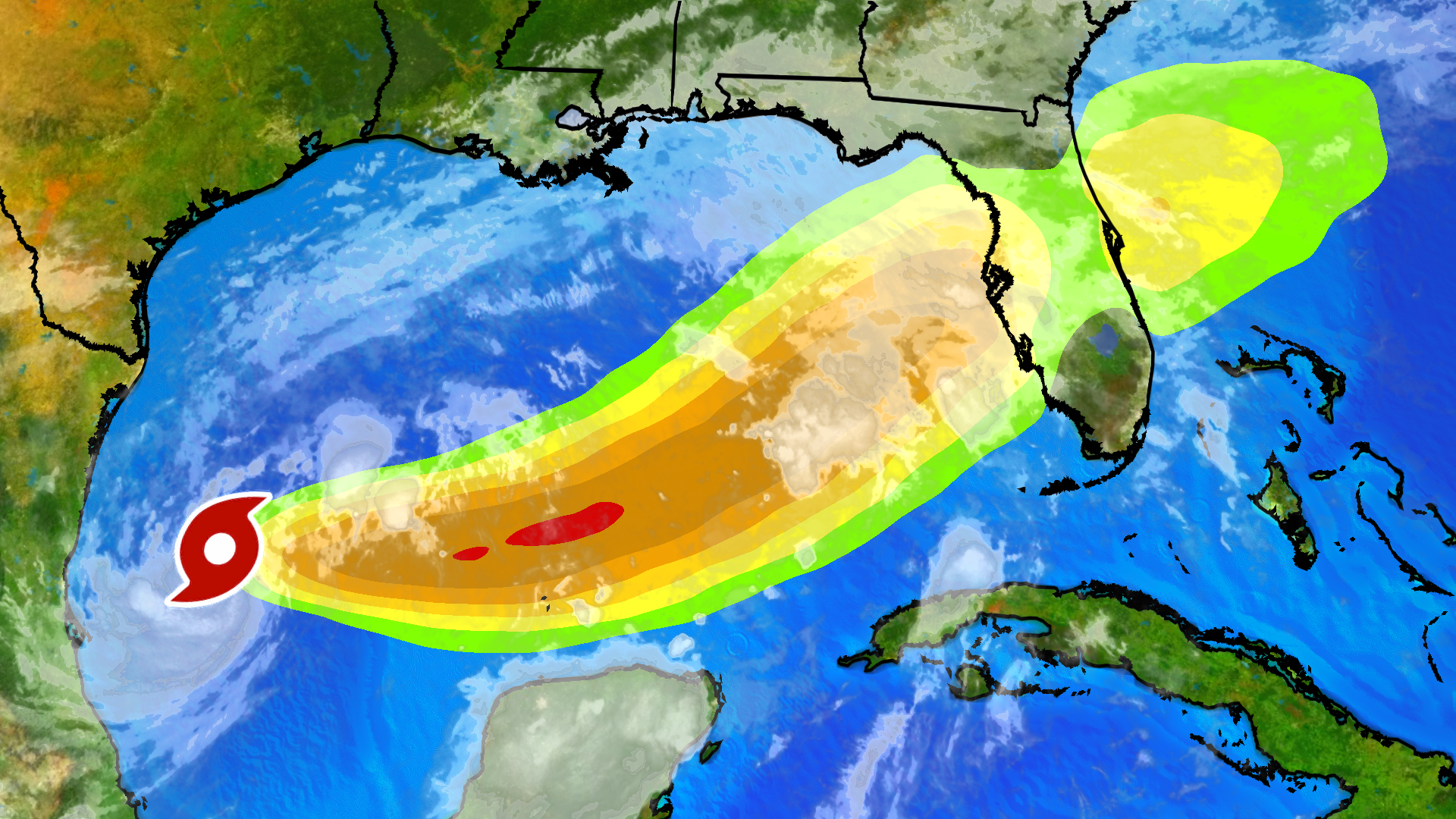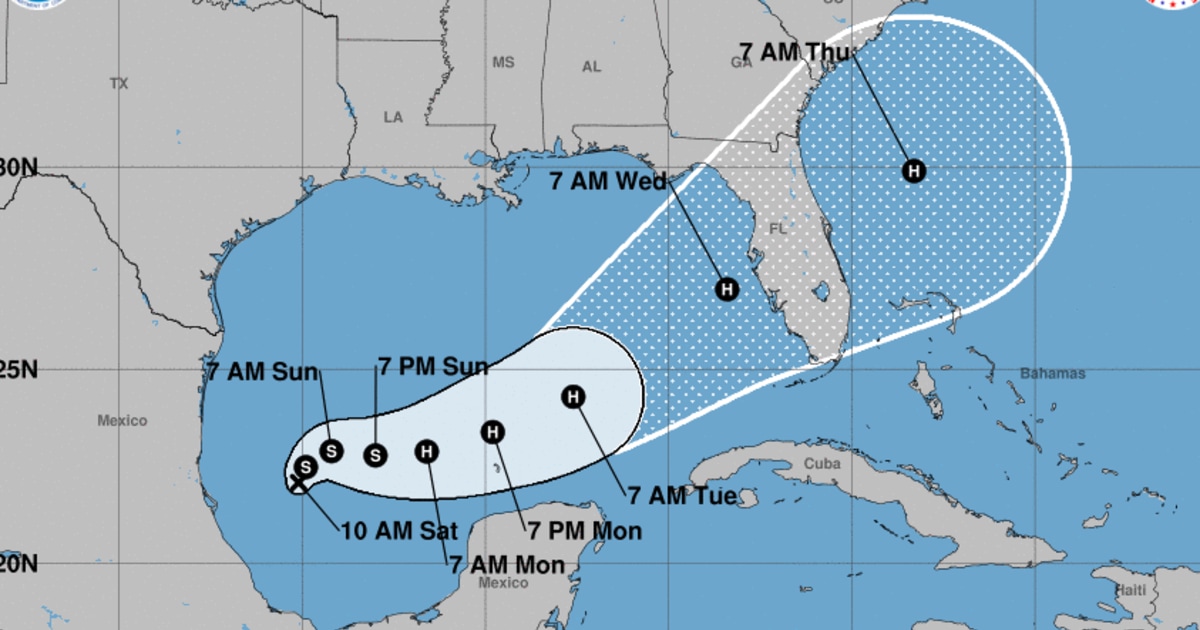According to the latest Storm Milton News, Storm Milton formed in the western Gulf of Mexico on Saturday, October 5, 2024. According to the National Hurricane Center, Milton is the 13th named storm of the season.

Also Read: Amazon Rainforest Fires Hit Brazil’s Indigenous Communities
The Storm Milton is expected to intensify due to low vertical wind shear and warm sea-surface temperatures, both of which create ideal conditions for hurricane development.
The NHC predicts that Milton will strengthen into a hurricane within 36 hours and a major hurricane (Category 3 or higher) within 72 hours.
The projected path of the storm indicates it will move eastward across the Gulf of Mexico with potential landfall on Florida’s west coast midweek. Maximum sustained winds are forecast to reach 115 mph.
According to the latest Storm Milton News, Florida is still recovering from the effects of Hurricane Helene, which made landfall on September 26 as a Category 4 storm. The state has already experienced severe flooding, power outages and destruction.
Storm Milton news indicates that the storm could bring additional heavy rainfall, storm surge and damaging winds to areas already affected by Helene.
Rainfall estimates predict 4 to 6 inches of rain across the Florida Peninsula with some areas experiencing up to 10 inches. This rainfall could exacerbate existing flooding conditions especially in cities like Tampa, Gainesville, Naples and Jacksonville.
The western Florida Peninsula is also at high risk for storm surge, which could lead to coastal flooding as early as Tuesday or Wednesday next week.
In preparation for Storm Milton, Florida Governor Ron DeSantis declared a state of emergency on Saturday, covering 35 counties across the state. This declaration will allow state officials to mobilize resources and implement emergency response efforts more effectively.
It also empowers local governments to take necessary actions in preparation for the storm. Governor DeSantis addressed that, despite recovery efforts from Hurricane Helene, the state is ready to face the challenges posed by Milton.
Search and rescue teams, power restoration crews and road-clearing operations are already being staged to respond to potential damage. Additionally, the Federal Emergency Management Agency has personnel on the ground in Florida.
FEMA has warned that heavy rainfall and storm surge from Milton could affect recovery efforts in areas impacted by previous hurricanes including Helene and Debby.
Tropical Storm Milton formed in the Gulf of Mexico on Saturday afternoon. Meteorologists from the National Hurricane Center have warned that this storm could develop into a weather event over the coming days.
Storm Milton is predicted to intensify as it travels through the warm waters of the Gulf by Monday. If the storm continues on its current trajectory, it may become a major hurricane by the time it nears Florida’s west coast midweek.
Storm Milton news indicates that it could bring torrential rains, damaging winds and storm surge to parts of Florida’s Gulf Coast starting Sunday. The heaviest rainfall is expected between Tuesday and Wednesday.
Storm Milton’s projected path suggests it will affect Central and South Florida, sparing the northern areas like Florida’s Big Bend region, which was hit hard by Hurricane Helene just last week.
Forecasters remain cautious but believe that Milton could intensify into a Category 3 hurricane before making landfall near Tampa. The combination of storm surge and heavy rainfall presents a flooding risk in the affected areas.
Governor Ron DeSantis declared a state of emergency in 35 counties across Florida. This enables the Florida National Guard and other state resources to assist affected areas during and after the storm.
Residents are advised to stock up on essential supplies like drinking water, non-perishable food, medications, batteries and other necessities.
The City of Tampa and other local authorities have urged residents to take precautions to protect homes from flooding by using sandbags and plastic covers.
The arrival of Tropical Storm Milton comes on the heels of Hurricane Helene, which devastated parts of Florida’s Big Bend region last week as a Category 4 hurricane.
Helene brought more than two feet of rain to certain areas of the Appalachian Mountains. In contrast, Milton is expected to affect regions farther south.
The National Weather Service and meteorologists have expressed concerns over the potential for back-to-back storms affecting already-vulnerable areas especially considering the toll of Hurricane Helene on emergency resources.
Also Read: Typhoon Krathon News: Deadly Storm Killed 2 in Taiwan
Storm Milton news highlights the risk of extreme rainfall and storm surges along Florida’s Gulf Coast particularly between Fort Myers and Tampa.
Heavy rains are forecast to start as early as Sunday and continue throughout the week with some areas predicted to receive up to a foot of rainfall.
The Interstate 4 corridor could experience the heaviest rainfall, while regions to the south such as Miami and Orlando. Coastal areas are at risk of storm surges, which could exceed the levels seen during Hurricane Helene.
Storm Milton news shows that the storm is expected to accelerate as it crosses the Gulf of Mexico with models predicting it will reach hurricane strength by Monday.
Meteorologists remain concerned that Milton could intensify into a Category 2 or 3 hurricane. Forecast models including the GFS and European models have highlighted a strong potential for Milton to become a storm by the middle of next week.
Forecasters from the National Hurricane Center have echoed these concerns, warning of multiple life-threatening hazards.
Hurricane Helene has left an impact on the state. The storm’s destructive path spanned over 500 miles. Over 200 deaths were reported across six states as a result of Helene with Florida experiencing the bulk of the destruction.
Local authorities fear the death toll could rise as recovery efforts continue. President Joe Biden visited the areas affected by Helene last week and promised federal support for the ongoing rebuilding process, which is estimated to cost billions of dollars.
The Florida communities devastated by Helene are still without essential services like running water, electricity and passable roads.
Storm Milton is forecast to move slowly through the southwestern Gulf of Mexico on Sunday, October 6 and continue its trajectory through the central and eastern Gulf over the following days.
By Monday and Tuesday, the storm is expected to be approaching the Florida Peninsula with hurricane watches and storm surge warnings likely to be issued by Sunday night.
The NHC is monitoring the storm and residents in areas are urged to stay updated on the latest forecasts. The Yucatan Peninsula, the Florida Peninsula, the Florida Keys and even the Bahamas are on high alert as Milton moves across the region.
An intensification is anticipated over the warm Gulf waters and by the time Milton reaches the Florida coast, it may be at or near major hurricane strength.
Storm Milton is forecast to bring rainfall to Florida with totals ranging from 5 to 12 inches across the Florida Peninsula and the Florida Keys.
Areas already saturated from Hurricane Helene’s rainfall are at an even greater risk of flooding particularly in low-lying regions and urban areas where drainage systems may already be overwhelmed.
Storm Milton’s heavy rainfall is expected to begin late Sunday and continue into the middle of next week with the heaviest downpours expected on Wednesday when the storm nears the coast.
The NHC warns that flash flooding and flooding are possible especially in regions that have already experienced above-average rainfall this year.
Tampa has received over 20 inches of rainfall above normal and cities like Melbourne, Fort Myers and Jacksonville have also seen a surplus.
In recent years, inland flooding has been responsible for more deaths than coastal impacts like wind and storm surges. The NHC reported that over 55 percent of hurricane-related fatalities between 2013 and 2023 were caused by rain-induced flooding.
Inland areas especially those along rivers and valleys, should prepare for flooding as Milton’s slow movement may cause heavy rain to persist over the same areas for extended periods.
Also Read: UK Shuts Down Last Coal Power Plant After 57 Years of Service






















